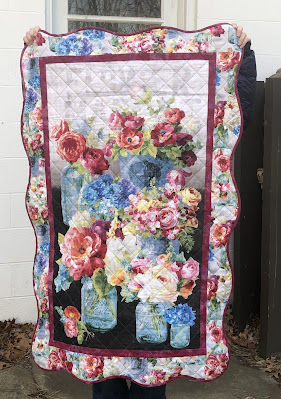I've been making a fair number of projects that include flying geese lately. Most of these projects use the four at a time method, which I really like. It is fast, easy, and I like to make them oversized so I can trim them and end up with them most accurate flying geese unit possible. :-)
There are a ton of tutorials on making four at a time flying geese, so I am not going to show how to do that. Instead, I am going to show you how I like to trim them. There are a couple of steps that are often overlooked, but they are VERY important to have the units turn out exactly as they should.
For demo purposed, I am using a unit that will measure 2 1/2" x 4 1/2" unfinished (2" x 4" finished).
Here's my untrimmed flying geese block. The block should be pressed well so it lays flat. Notice the orientation of the V. This is important to be able to trim the first two sides accurately!
Even though it may look like it, I do not using the lines on the cutting mat to trim blocks. I like to use a square ruler for trimming, so I am using a 6 1/2" square ruler in this tutorial. (Yes, I know there are special rulers for trimming flying geese. I do not own any of those, and neither do many of my students. That is why I'm doing this tutorial. 😉
Disclaimer: I am right handed and the pictures below are taken accordingly.
The first thing I do is orient the 45 degree angle along the right side of the V. Don't worry about lining up anything else just yet. I will show you the most important places to look and align in the next series of pictures.
The blue arrows in the picture below are what I like to call "alignment points." I am checking for an accurate 45 degree angle of the V, the correct width, the correct height, and the correct center point of the block. Remember that the actual alignment points will change depending on the size of flying geese you are making, but the process will be the same.
In this example, the flying geese that will measure 2 1/2" x 4 1/2" unfinished,
so the pictures shows that I am checking for an accurate 45 degree angle of the V,
the correct width (4 1/2"), the correct height (2 1/2"),
and the correct center point of the block (2 1/4").
I am making a flying geese block that measures 2 1/2" x 4 1/2". With that in mind, the following steps should be taken and points should be noted and used to align the ruler before trimming. (See the arrows in the next pictures to help you with alignment.)
1) Align the 45 degree angle of the ruler along the right side of the V. (see purple arrows)
2) The width of the block is 4 1/2" so the center of the block (the tip/point of the V) should be 2 1/4". (see the white arrow)
3) Once you have aligned the center point, look to the left and make sure the block extends at least to, but preferably a little past, the 4 1/2" line. Check at the top and bottom of the left side of the block. (see the blue arrows)
4) Check along the bottom to make sure the block extends at least to, but preferable a little past, the 2 1/2" line. (see the orange arrows)
5) Another thing to look for at this point is to make sure that the fabric extends at least 1/4" from the bottom of the V. This is for the 1/4" seam allowance which will help you not lose the point when you sew the block to another unit or block. (see the center orange arrow)
**If everything is aligned properly, the right corner of the ruler should intersect with the top, right side of the V. (see top purple arrow) and the 4 1/2" ruler mark should intersect with the top, left side of the V. (see the top blue arrow)
6) Once everything is correct, trim the right side and top of the flying geese block.
7) Rotate the block so the V is upside down and the trimmed sides are on the left and bottom.
8) Verify that you have the accurate alignment points again.
A) The left side of the block should align with the 4 1/2" mark on the ruler. (see blue arrows)
B) The bottom should align with the 2 1/2" mark on the ruler. (see orange arrows)
C) The tip of the V should align with the 2 1/4" mark on the ruler (see pink arrow)
D) Fabric should extend at least 1/4" past the tip of the V. (see pink arrow)
9) Trim the right side and top.
Here is a perfectly sized 2 1/2" x 4 1/2" flying geese block, ready to be used.


















